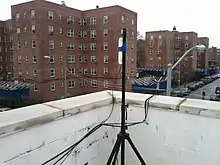| Red-Hook Wi-Fi | |
|---|---|
| Mission statement | Resilience, Opportunity, Community and Social Justice. |
| Type of project | Non Commercial |
| Products | Mesh Networking |
| Location | Red Hook, Brooklyn. United States of America. |
| Owner | Red Hook Initiative |
| Established | November 2011 |
| Status | Active |
| Website | redhookwifi |
Red Hook Wi-Fi is a free-to-use, Wi-Fi mesh network that provides internet access to the Red Hook neighborhood of Brooklyn, New York.[1] It is operated by the Red Hook Initiative.
Background
Due to the location of Red Hook, Brooklyn, between the Red Hook Channel and the Buttermilk Channel, many of its residents face various challenges in accessing broadband service.[2] A survey found out that many people in the area accessed the internet primarily through mobile phones and that over 30% of the population did not have broadband access at home.[2][3]


Beginning in Fall 2011, the Red Hook Initiative (RHI), a Brooklyn non-profit, approached the Open Technology Institute about collaborating on a community wireless network. RHI wanted a way to communicate with the residents immediately around its community center.
When the network was initially launched, it had support for up to 150 simultaneous users and ran on an open-software platform called Commotion.[4]

Hurricane Sandy
In 2012, after Hurricane Sandy struck the area, and many internet and communication systems were down throughout much of the city,[5] Red Hook remained connected through its mesh network and the headquarters of the Red Hook Initiative became a hub for volunteer coordination, donation collections food distribution as residents came to the Red Hook Initiative's office to charge their devices and connect to the internet.[6][7]
Shortly afterwards, the Federal Emergency Management Agency (FEMA) connected Red Hook Wi-Fi to its satellite system,[8] linking itself, the residents and the Red Cross into a communication matrix that could be used to find out about emergency relief, food banks as well as shelter locations.[9][10][6]
After the relief efforts had finished, a team led by the Red Hook Initiative continued to make improvements to the mesh network by installing nano stations powered by solar panels on rooftops around the Red Hook neighborhood.[11]
Though the Red Hook Wi-Fi project was already in the works before Hurricane Sandy struck, it gained additional media attention after the storm.[12]
In 2015, Red Hook Wi-Fi was selected to be part of the city's resiliency initiative — from a group of 27 finalists competing in the Resiliency Innovations for a Stronger Economy.[13][14]
References
- ↑ Kasakove, Sophie; Williams, Tracie (29 January 2019). "Is New York City's Public Housing Ready for the Next Storm?". Retrieved 16 April 2019.
- 1 2 Staff (25 September 2013). "Local Connections: The Red Hook WiFi Project". Urban Omnibus. Retrieved 15 April 2019.
- ↑ Burrington, Ingrid (31 October 2017). "What Happens to the Internet After a Disaster?". Intelligencer. Retrieved 15 April 2019.
- ↑ "Do-It-Yourself Internet in Brooklyn". The Washington Post. Retrieved 15 April 2019.
- ↑ "Rising to the Challenge: Red Hook Initiative". NYCEDC.
- 1 2 Kazansky, Becky (6 November 2020). "In Red Hook, Mesh Network Connects Sandy Survivors Still Without Power". TechPresident.
- ↑ Zandt, Deanna. "What Sandy Has Taught Us About Technology, Relief and Resilience". Forbes.
- ↑ Masterson, Andrew (15 May 2014). "Meshnets serve communities when internet fails". The Sydney Morning Herald.
- ↑ Cohen, Noam (22 August 2014). "Red Hook's Cutting-Edge Wireless Network". The New York Times.
- ↑ Robbins, Liz (1 March 2016). "New Weapon in Day Laborers' Fight Against Wage Theft: A Smartphone App". The New York Times.
- ↑ Dodd, Justin. "After Superstorm Sandy, This Brooklyn Neighborhood Reinvented Community Wifi". Inverse. Retrieved 15 April 2019.
- ↑ "United States of America Global Information Society Watch". www.giswatch.org. Retrieved 15 April 2019.
- ↑ "Mayor De Blasio Announces Selection Of RISE : NYC Technologies To Be Deployed At Sandy-Impacted Small Businesses Across New York City". NYCEDC.
- ↑ Melendez, Steven (5 May 2015). "This Mesh We're In: Why Communities Are Building An Internet That's More Local". Fast Company. Retrieved 15 April 2019.